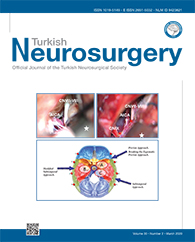2China International Neuroscience Institute (China-INI), Beijing, China
3Shunyi District Hospital, Department of Neurosurgery, Beijing, China DOI : 10.5137/1019-5149.JTN.27824-19.5 AIM: To summarize the clinical outcomes, follow-up results and to discuss the optimal therapeutic strategy for pericallosal artery aneurysms (PAAs).
MATERIAL and METHODS: From January 2013 to May 2017, the charts of 49 patients with PAAs, representing 2.43% of 2,018 consecutive patients with intracranial aneurysms (IAs) were reviewed. The clinical and radiological data of these patients were retrospectively analyzed.
RESULTS: There were no technical failures in the clipping group, but one patient in the coiling group presented rebleeding during the operation, resulting in a poor prognosis. Although the difference was not significant, the coiling group had a better complete recovery rate than the clipping group [overall: coiling, n=20 (87.0%) vs clipping, n=11 (68.8%), p=0.33; unruptured PAAs: coiling, n=12 (92.3%) vs clipping, n=5 (83.3%); ruptured PAAs: coiling, n=8 (80%) vs clipping, n=6 (60%), p=0.63]. One patient in the coiling group exhibited recurrence. No patients experienced rebleeding during the follow-up period in either group.
CONCLUSION: In our study, both endovascular coiling and microsurgery were technically feasible and achieved favorable clinical outcomes in patients with PAAs. Longer radiological follow-up is necessary. Patients should be evaluated by a multidisciplinary team prior to determining the optimal treatment modality.
Keywords : Intracranial aneurysm, Pericallosal artery aneurysm, Distal anterior cerebral artery aneurysm, Surgery, Treatment




